As many as 2,000 leopard sharks have mysteriously died in the San Francisco Bay over the past few months. The California Department of Fish and Wildlife says determining the cause is not a priority for the state since the sharks are not threatened or endangered, however, scientists say additional research and resources are crucial since the threat is now believed to be preying on other marine life.
“This year is unusual in that there has been a large number of other species that have also been dying,” said Dr. Mark Okihiro, a research scientist with the California Department of Fish and Wildlife. “This pathogen can tackle a variety of different species … we've had a much more diverse group of fish that have been found dead in the San Francisco Bay.”
At least 500 bat rays, hundreds of striped bass, 50 smooth-hound sharks and about 100 halibut died in the bay between February and July, according to Okihiro’s estimates.
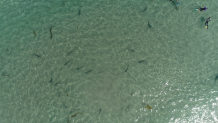
Tiny Organism Blamed for Massive Shark Die-Off
Similar shark deaths in the area date back 50 years and have gone unexplained. Okihiro, however, now believes a parasite may be behind the mysterious die-off that has plagued the Bay Area.
U.S. & World
“We're pretty confident at this point,” Okihiro said. “It's called Miamiensis avidus … it's a small single celled organism. It's very similar to the common amoeba.”
Okihiro regularly performs necropsies on stranded sharks found along the bay and says researchers at UC San Francisco helped him identify parasite DNA in a large number of those shark samples.
Humans who swim in the Bay or eat infected sea life are unlikely to become infected.
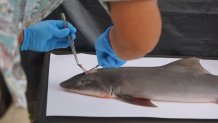
Parasite Eats Away at the Brain
The deadly pathogen sneaks in through the shark’s nose and slowly eats away at the brain, Okihiro says, oftentimes causing sharks to beach themselves or swim in circles. A leopard shark, exhibiting that very behavior, was spotted just outside the ballpark during a recent San Francisco Giants game and was likely in the process of dying.
Okihiro estimates 1,000 to 2,000 leopard sharks have died in the bay so far this year, however, he concedes the death toll could actually be higher.
“The sharks you see on shore are just a small fraction of the sharks that are actually dying in the bay,” he said.
Sharks are not naturally buoyant. Unless they are actively swimming, their bodies sink. As a result, infected sharks that die in deep water may never actually wash up on shore.
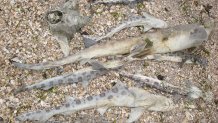
Bay Area Death Toll Likely More Grim
“I think it's almost certain that the number of sharks that have died are much higher,” said Dr. Andrew Nosal, a marine biologist at UC San Diego and a top expert on leopard sharks, the main species that has washed up dead in the bay. “We have to find out what's killing these sharks.”
Nosal’s ongoing research centers on the migration patterns of leopard sharks. He says it is crucial the state dedicate resources towards investigating the cause of the sharks’ mysterious demise.
“If we don't find out, then there's nothing we can do about it,” he said.
The NBC Bay Area Investigative Unit recently joined Nosal and his colleague on their research boat off the coast of San Diego’s La Jolla Cove, a known leopard shark hotspot.
“If you remove leopard sharks from the population, it is going to have a chain reaction,” Nosal said. “They're eating other things and other things are eating them.”
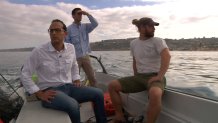
While Nosal says he is concerned that other species are now dying, he also fears the threat could spread to other ecosystems along the West Coast.
“It's isolated in San Francisco [Bay], but are we going to start seeing this up and down the coast of California?”
For now, no one knows for certain.
“I think that's what the scariest part is,” Nosal said.
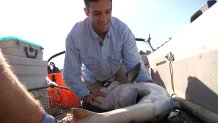
Researching Shark Tissue In His Dining Room
Researching the cause of the die-off isn’t actually Dr. Mark Okihiro’s job. He is officially in charge of assessing the health of white sea bass for the California Department of Fish and Wildilfe, but he’s been researching shark deaths from home in his spare time.
He performs necropsies on the dead sharks on his patio, studies bacteria samples in his kitchen, and examples tissue samples in his living room.
“We’ll probably have to wash this [table] cloth before thanksgiving,” Okihiro joked while giving the Investigative Unit a tour of makeshift lab in Southern California.
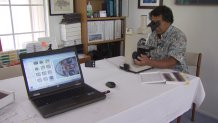
'You Work With What you Have'
Field work on sharks is relatively rare. Okihiro, however, says additional research and resources are needed to definitely determine the cause of the die-off.
“In Fish and Wildlife we're spread pretty thin,” Okihiro said. “You know, you work with what you have.”
Through phone calls and email, the NBC Bay Area Investigative Unit requested an interview with the department’s director, Charlton Bonham, to discuss the “leopard shark die-off” and the “agency’s overall involvement in the issue, including funding.”
However, the department’s public relations manager, Deputy Director Jordan Traverso, said Gabe Tiffany, Deputy Director of Administration, would be the best person to answer those questions.

State Snubs Shark Research, Prioritizes Funding to Higher-Risk Wildlife
“We have a lot of constraints on how our programs are funded,” Tiffany said.
During the interview, Tiffany could not answer how much money the department currently allocates towards researching the recent die-off, nor could he answer specific questions about the state’s involvement in the research effort.
Following the interview, the department confirmed it is not currently providing any funding towards investigating the shark deaths.
While federal dollars pay the bulk of Okihiro’s salary, benefits, and operating expenses, the California Department of Fish and Wildlife funds about 25 percent, totaling $35,925.
“None of this is explicitly for, or directed at, disease or pathogen analysis of sharks and rays,” Traverso noted in an email to the Investigative Unit.
“Because of Dr. Okihiro’s knowledge and experience with marine fish diseases, he is occasionally called in to analyze acute disease or pathogen events for other wild, marine fish species, including species of sharks and rays. But again, this is not explicitly part of his job,” Traverso said.
While the state Legislature and governor could approve additional funds for shark research in the future, Traverso said the California Department of Fish and Wildlife will continue to dedicate its current resources to higher-risk wildlife.
“Some of the current priorities include implementing the Marine Life Protection Act and establishing and monitoring Marine Protected Areas, rebuilding impacted fisheries (Chinook salmon in-river and the ocean, red urchin, red abalone), addressing the kelp die-off along the north-central and north coast, and implementing a different water management scheme to provide healthier fish populations in the Central Valley rivers, Delta, and San Francisco Bay,” Traverso said in a statement.”
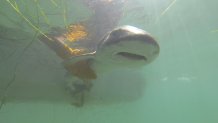
'A Canary in the Coal Mine'
Leopard sharks are not a threatened or endangered species. In fact, they are some of the most abundant sharks off the California coast. However, Nosal said that makes them canaries in a sort of Bay Area coal mine since their abundant population appears to be making them especially vulnerable.
“When they die and wash ashore, it’s pretty obvious,” he said. “We see it. But what about all the other species that, perhaps, are getting sick and dying and simply sinking to the bottom that we just don’t know about? There’s a lot more at stake here than just leopard sharks.”
[[401915696, C]]



